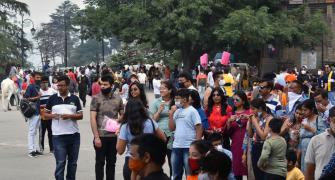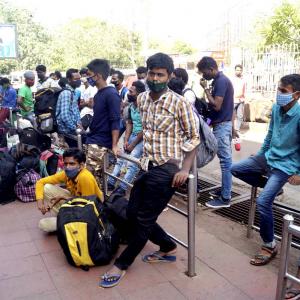While many of the lost jobs will come back, the current loss is huge and its impact on the households that have suffered because of this cannot be captured in the comfort that jobs will come back eventually, observes Mahesh Vyas.

A comparison of the quarter ended March 2021 with the quarter ended March 2020 provides a view of how India dealt with the COVID-19 shock.
The quarter ended March 2020 reflects the position before the shock and the quarter ended March 2021 was the position at the end of a year since the shock. Using quarterly data removes the noise in monthly data, if any, and making year-on-year comparisons removes the effects of seasonality, if any.
One problem with using the March 2020 quarter as a pre-Covid quarter is that it wasn't entirely free of the effects of Covid. The virus had started curtailing activities by late February and finally, the nationwide lockdown began on March 24, 2020.
In January 2020, employment was estimated at 410 million. This dropped to 406 million in February and then to 396 million in March that year. Therefore, using the quarter ended March 2020 as a pre-Covid quarter is to understate the pre-Covid conditions. With this caveat, it may be noted that employment during the quarter ended March 2020 was 406 million.
In the quarter ended March 2021, employment is estimated at 399.7 million. Therefore, one year after the onset of Covid, India was left with a shortfall of 6.3 million jobs.
Note that this is not the loss of jobs during the year of the Covid pandemic. That is a much bigger number. Many of the lost jobs came back.
Our interest is in the situation before and after the shock. We find that all jobs could not be recovered. The net shortfall is of 6.3 million jobs, implying a loss of 1.5 per cent of the jobs.
The second wave of Covid hit India exactly a year after the first. This one cost India an additional 13.3 million jobs.
Employment dropped from 399.7 million in the quarter ended March 2021 to 386.4 million in the quarter ended June 2021.
So, compared to the pre-Covid March 2020 quarter, India today faces a loss of a massive 19.6 million jobs.
It is not entirely fair to compare the 13.3 million jobs lost in the second wave with the 6.3 million jobs lost in the year since the first wave. Experience tells us that many of the jobs lost initially do come back eventually.
Employment at the end of the quarter ended June 2020 was a whopping 78 million lower than it was in the March 2020 quarter. But that massive shortfall has been largely made up for, leaving a shortfall of only 6.3 million as of the quarter of March 2021.
Similarly, the 13.3 million shortfall seen in the first quarter of the second wave will be narrowed in the coming quarters.
While many of the lost jobs will come back, the current loss is huge and its impact on the households that have suffered because of this cannot be captured in the cold statistics rolled out here or in the comfort that jobs will come back eventually.
Many of those who got their jobs back or found alternative jobs got these at lower wage rates. Household incomes have fallen a lot more than employment has.
The gender distribution of job losses in the second wave is somewhat ominous.
First, a simple structural fact -- nearly 90 per cent of the jobs are held by males. Women account for only about 10 per cent of the jobs, but they made for 23 per cent of the loss of jobs a year after India was struck by Covid.
As of the quarter of March 2021, of the 399.7 million jobs, women accounted for only 41.8 million jobs. But, of the 6.3 million jobs lost over the preceding year, women accounted for 1.5 million lost jobs.
The most disproportionate loss of jobs because of the first wave of COVID-19 was among urban women. Urban women account for about three per cent of total employment. But they accounted for 39 per cent of total job losses.
Of the 6.3 million jobs lost, urban women accounted for a loss of 2.4 million.
This is not how it played out in the second wave. Urban women suffered the least loss of jobs. The burden of job losses has shifted to men.
During the April-June 2021 quarter, urban males faced a disproportionately higher loss of jobs.
Urban males account for about 28 per cent of the total employment in India. They accounted for a lower 26 per cent of the loss of jobs till March 2021. But, in the quarter ended June 2021, their share in total job losses was higher at 30 per cent.
Arguably, urban male jobs are the better quality jobs and their disproportionate loss could imply a greater fall in income than witnessed so far.
It is also likely that women are often the second earning member of a household. The loss of jobs among women more often than not implies a fall in income but not a complete loss of income.
But a loss of job among men often implies complete loss of livelihood. This greater loss of urban male jobs is worrisome.
The impact of this on income will be known when the income data for the quarter are released in November 2021.
Mahesh Vyas is MD & CEO, CMIE P Ltd.










